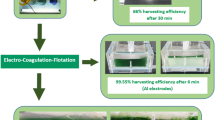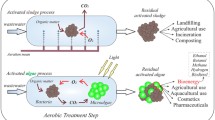Abstract
One of the important living organisms in stagnant waters, surface waters, water reservoirs, pools and dams is microalgae. Various methods have been developed and studied for the removal of these microscopic organisms from drinking water, of which the sedimentation or flocculation is one of the significant methods. The method is based on using sediments substance or flocculants. This study aimed to introduce feasible, harmless and suitable biological flocculants and evaluate their ability to precipitate Cyclotella diatoms. The presence of a large number of Cyclotella diatoms in water creates an unpleasant color and odor in the water. For this purpose, autoflocculation–sedimentation and bioflocculation processes were used to harvest Cyclotella. The effect of pH, mixing speed and time on harvest efficiency for autoflocculation–sedimentation and bioflocculation processes was investigated. The autoflocculation results showed that the removal efficiency increased with increasing pH, decreasing mixing speed and increasing settling time. For bioflocculation, Scenedesmus microalgae were used to isolate Cyclotella diatoms, and by examining the parameters affecting the rate of microalgae isolation, the optimal conditions have been determined. The ratio of 1:1 combination of microalgae–diatomaceous earth and pH = 10 and residence time of 120 min can yield up to 83% isolation and sedimentation of Cyclotella microalgae, which is a very efficient and inexpensive environmentally friendly method for the separation of infected microalgae from used drinking water.





Similar content being viewed by others
References
Alam MA, Vandamme D, Chun W, Zhao X, Foubert I, Wang Z, Muylaert K, Yuan Z (2016) Bioflocculation as an innovative harvesting strategy for microalgae. Rev Environ Sci Bio/technol 15(4):573–583
Aljuboori AHR, Idris A, Al-joubory HHR, Uemura Y, Abubakar BI (2015) Flocculation behavior and mechanism of bioflocculant produced by Aspergillus flavus. J Environ Manage 150:466–471
Barros AI, Gonçalves AL, Simões M, Pires JC (2015) Harvesting techniques applied to microalgae: a review. Renew Sustain Energy Rev 41:1489–1500
Choi O, Dong D, Kim J, Maeng SK, Kim K, Lee JW (2021) Application of extracellular polymeric substances (EPSs)-bioflocculant for recovery of microalgae. J Korean Soc Water Wastewater 35(1):63–69
Deconinck N, Muylaert K, Ivens W, Vandamme D (2018) Innovative harvesting processes for microalgae biomass production: a perspective from patent literature. Algal Res 31:469–477
Després V, Huffman JA, Burrows SM, Hoose C, Safatov A, Buryak G, Fröhlich-Nowoisky J, Elbert W, Andreae M, Pöschl U (2012) Primary biological aerosol particles in the atmosphere: a review. Tellus B Chem Phys Meteorol 64(1):15598
Fasaei F, Bitter J, Slegers P, Van Boxtel A (2018) Techno-economic evaluation of microalgae harvesting and dewatering systems. Algal Res 31:347–362
Gerardo ML, Van Den Hende S, Vervaeren H, Coward T, Skill SC (2015) Harvesting of microalgae within a biorefinery approach: a review of the developments and case studies from pilot-plants. Algal Res 11:248–262
Golzary A, Tavakoli O, Rezaei Y, Karbassi A (2018) Wastewater treatment by Azolla filiculoides: a study on color, odor, COD, nitrate, and phosphate removal. Pollution 4(1):69–76
Khalili Z, Jalili H, Noroozi M, Amrane A, Ashtiani FR (2020) Linoleic-acid-enhanced astaxanthin content of Chlorella sorokiniana (Chlorophyta) under normal and light shock conditions. Phycologia 59(1):54–62
Li Y, Xu Y, Song R, Tian C, Liu L, Zheng T, Wang H (2018) Flocculation characteristics of a bioflocculant produced by the actinomycete Streptomyces sp. hsn06 on microalgae biomass. BMC Biotechnol 18(1):1–10
Mathimani T, Mallick N (2018) A comprehensive review on harvesting of microalgae for biodiesel–key challenges and future directions. Renew Sustain Energy Rev 91:1103–1120
Mohammed JN, Dagang WRZW (2019) Role of cationization in bioflocculant efficiency: a review. Environ Process 6(2):355–376
Mustafa HM, Hayder G, Jagaba AH (2021) Microalgae: a renewable source for wastewater treatment and feedstock supply for biofuel generation. Biointerface Res Appl Chem 11:7431–7444
Nazari MT, Rigueto CVT, Rempel A, Colla LM (2021) Harvesting of Spirulina platensis using an eco-friendly fungal bioflocculant produced from agro-industrial by-products. Bioresour Technol 322:124525
Pei X-Y, Ren H-Y, Liu B-F (2021) Flocculation performance and mechanism of fungal pellets on harvesting of microalgal biomass. Bioresour Technol 321:124463
Prakash N, Sockan V, Jayakaran P (2014) Waste water treatment by coagulation and flocculation. Int J Eng Sci Innov Technol (IJESIT) 3(2):479–484
Rinanti A, Purwadi R (2018). Harvesting of freshwater microalgae biomass by Scenedesmus sp. as bioflocculant. In: The 4th international seminar on sustainable urban development: IOP Conference Series, Earth and Environmental Science
Salim S, Bosma R, Vermuë MH, Wijffels RH (2011) Harvesting of microalgae by bio-flocculation. J Appl Phycol 23(5):849–855
Sarang M, Nerurkar A (2020) Amyloid protein produced by B. cereus CR4 possesses bioflocculant activity and has potential application in microalgae harvest. Biotechnol Lett 42(1):79–91
Sforza E, Gris B, de Farias SC, Morosinotto T, Bertucco A (2014) Effects of light on cultivation of Scenedesmus obliquus in batch and continuous flat plate photobioreactor. Chem Eng Trans. https://doi.org/10.3303/CET1438036
Spilling K, Seppälä J, Tamminen T (2011) Inducing autoflocculation in the diatom Phaeodactylum tricornutum through CO2 regulation. J Appl Phycol 23(6):959–966
Zhou W, Ruan R, Wang J (2015) Bio-flocculation of microalgae: status and prospects. Curr Biotechnol 4(4):448–456
Zhu L, Li Z, Hiltunen E (2018) Microalgae Chlorella vulgaris biomass harvesting by natural flocculant: effects on biomass sedimentation, spent medium recycling and lipid extraction. Biotechnol Biofuels 11(1):1–10
Zou X, Li Y, Xu K, Wen H, Shen Z, Ren X (2018) Microalgae harvesting by buoy-bead flotation process using Bioflocculant as alternative to chemical Flocculant. Algal Res 32:233–240
Acknowledgments
The authors wish to thank all who assisted in conducting this work.
Author information
Authors and Affiliations
Corresponding author
Ethics declarations
Conflict of interest
The authors declare no conflict of interest.
Additional information
Editorial responsibilty: Samareh Mirkia.
Rights and permissions
About this article
Cite this article
Bakhtiari, H., Taghavi, L., Mirbagheri, S.A. et al. Effective harvesting of the microalgae Cyclotella via autoflocculation and bioflocculation. Int. J. Environ. Sci. Technol. 19, 6421–6428 (2022). https://doi.org/10.1007/s13762-021-03834-w
Received:
Revised:
Accepted:
Published:
Issue Date:
DOI: https://doi.org/10.1007/s13762-021-03834-w




